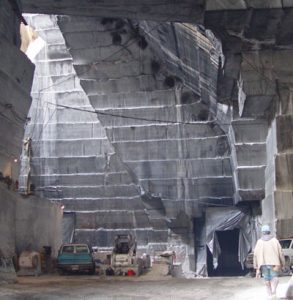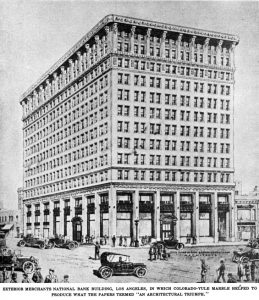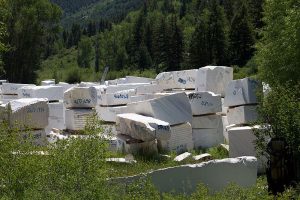
Did you know that the Tomb of the Unknown Soldier and the Lincoln Memorial in Washington, D.C. are constructed of marble quarried here in Colorado? The stone comes from the Colorado Yule Marble quarry in the Crystal River valley near Marble, between Carbondale and Crested Butte. Colorado Yule marble, named for nearby Yule Creek, is a special variety of marble found only in this location. Yule marble has been used in buildings and monuments across the United States. Here in Denver it’s also been used in many state government buildings, including the building that houses our library.

The Colorado Yule Marble Company was founded by Channing Meek in 1905, although marble had been discovered in the area as early as the 1870s. The town of Marble was incorporated in 1899. It was after the turn of the century, however, when marble became especially fashionable. With financial assistance from the Rockefellers, Meek spent $2.5 million establishing the quarry and building a power plant and a railroad to the processing mill site. During its first few years the operation employed nearly 900 workers, many of them Italian immigrants. “Colorado Marble and Building Stone is the Finest in the World,” proclaimed the 1909-10 report of the state’s Bureau of Labor Statistics in a profile of Yule Marble, which you can read online from our library.
In 1912 an avalanche destroyed the mill, but it was soon rebuilt and back in operation. That summer, Meek, the founder and company president, was killed in a trolley accident on his way between the quarry and the mill. The operation continued with new leadership, however, and between 1914 and 1916 supplied stone to Washington, D.C. for the Lincoln Memorial.
Over the next few years, fires, floods, the coming of WWI, and labor troubles tested the company. It was foreclosed and split into two companies and sold; however, in 1924 the two companies merged to form the Consolidated Yule Marble Company. It was sold again in 1928, and in 1930, it was chosen to provide the stone for the Tomb of the Unknowns. “The company was chosen because it had the only quarry capable of cutting a single block of marble large enough for the proposed design,” according to an article in the Colorado Encyclopedia.


By 1941, demand for marble had decreased as cheaper building materials were being introduced and modernist styles favored steel and glass. The quarry was shut down in the fall of that year, just prior to America’s entry into WWII. During and after the war, the quarry site sat mostly vacant until 1990, when it was finally reopened. A series of different owners have operated the site since that time. In 2004, marble was declared the State Rock.
Today, scattered marble remnants can still be seen near the quarry site. The Marble Historical Society operates a museum, housed in a historic 1910 schoolhouse, which includes exhibits on the history and geology of the area. The museum is open in the summer through early fall.

- How to Spot the Differences Between Eagles and Hawks - August 16, 2021
- How Transportation Projects Help Tell the Story of Colorado’s Past - August 9, 2021
- Time Machine Tuesday: The Night the Castlewood Canyon Dam Gave Way - August 3, 2021